Overview
Pooch belly, often referred to as a 'mommy pouch,' presents a noticeable bulge in the lower abdomen, impacting individuals due to various factors including hormonal changes, weight fluctuations, and lifestyle choices. Understanding pooch belly is crucial, as it addresses not only the physical implications—such as increased health risks—but also the significant emotional effects on self-esteem and body image. This highlights the necessity for a holistic management approach that encompasses:
- Exercise
- Nutrition
- Emotional support
Introduction
In a world where body image often dictates self-esteem, the issue of pooch belly—commonly referred to as the 'mommy pouch'—has emerged as a significant concern for many individuals. This condition, characterized by a noticeable bulge in the lower abdomen, transcends mere aesthetics; it affects emotional well-being and overall health. Various factors contribute to the development of pooch belly, including:
- Hormonal changes
- Genetic predispositions
- Lifestyle choices
Understanding its implications is essential. As awareness grows, so does the need for effective strategies to tackle this challenge. These strategies encompass:
- Exercise
- Nutrition
- Non-surgical treatments
This article explores the multifaceted nature of pooch belly, debunking myths, examining its causes and effects, and offering actionable insights for those seeking to reclaim their confidence and health.
Defining Pooch Belly: Understanding the Basics
What is pooch belly? This term describes the pooch abdomen, commonly referred to as a 'mommy pouch,' characterized by a noticeable bulge in the lower abdominal area, typically situated below the navel. This condition raises the question of what is pooch belly and is particularly prevalent among women, especially after childbirth. However, it can also affect individuals of all genders and ages due to various factors, including weight fluctuations, aging, and lifestyle choices.
Understanding what is pooch belly is essential, as this abdominal issue extends beyond mere physical appearance; it significantly influences emotional well-being and self-esteem. Research indicates that individuals with excess abdominal fat face a 32% higher risk of early death compared to those classified as obese. This highlights the serious health implications associated with this condition. Obesity is defined as a BMI of 30 or greater, providing critical context for understanding abdominal fat in relation to overall health.
The demographics of those affected by abdominal fat reveal a diverse range, with many experiencing this issue due to the natural changes that occur in the body over time. Health experts often observe that understanding what is pooch belly can lead to profound psychological effects, influencing self-image and confidence. For example, the phrase 'mommy pouch' can trigger feelings of inadequacy in new mothers, as societal beauty standards frequently disregard the realities of post-pregnancy bodies, making many wonder what is pooch belly.
Expert opinions highlight the significance of addressing both the physical and emotional aspects of what is pooch belly. Many health professionals advocate for a holistic approach that includes exercise and nutrition, as these can help mitigate the effects of what is pooch belly. Regular physical activity not only aids in reducing abdominal fat but also improves mood and motivation, contributing to a more positive self-image.
As Craig M. Hales, M.D. noted, the age-adjusted prevalence of obesity among U.S. adults was 42.4% in 2017–2018, underscoring the importance of addressing these issues in the workplace.
Foresight Health Coaching provides customized services, including nutrition plans and exercise programs specifically designed to assist individuals in managing excess weight effectively. Their membership options offer access to resources and support that enable individuals to make healthier lifestyle choices. Case studies demonstrate the effect of canine weight on self-worth, showing that people who participate in supportive wellness programs frequently report enhanced body image and emotional well-being.
Foresight Health Coaching's corporate partnership offers organizations the opportunity to build a healthier, happier, and more cohesive team culture. By cultivating a culture of health and togetherness, organizations can play a crucial role in assisting individuals in managing the challenges related to canine obesity, ultimately resulting in a healthier, more self-assured workforce.
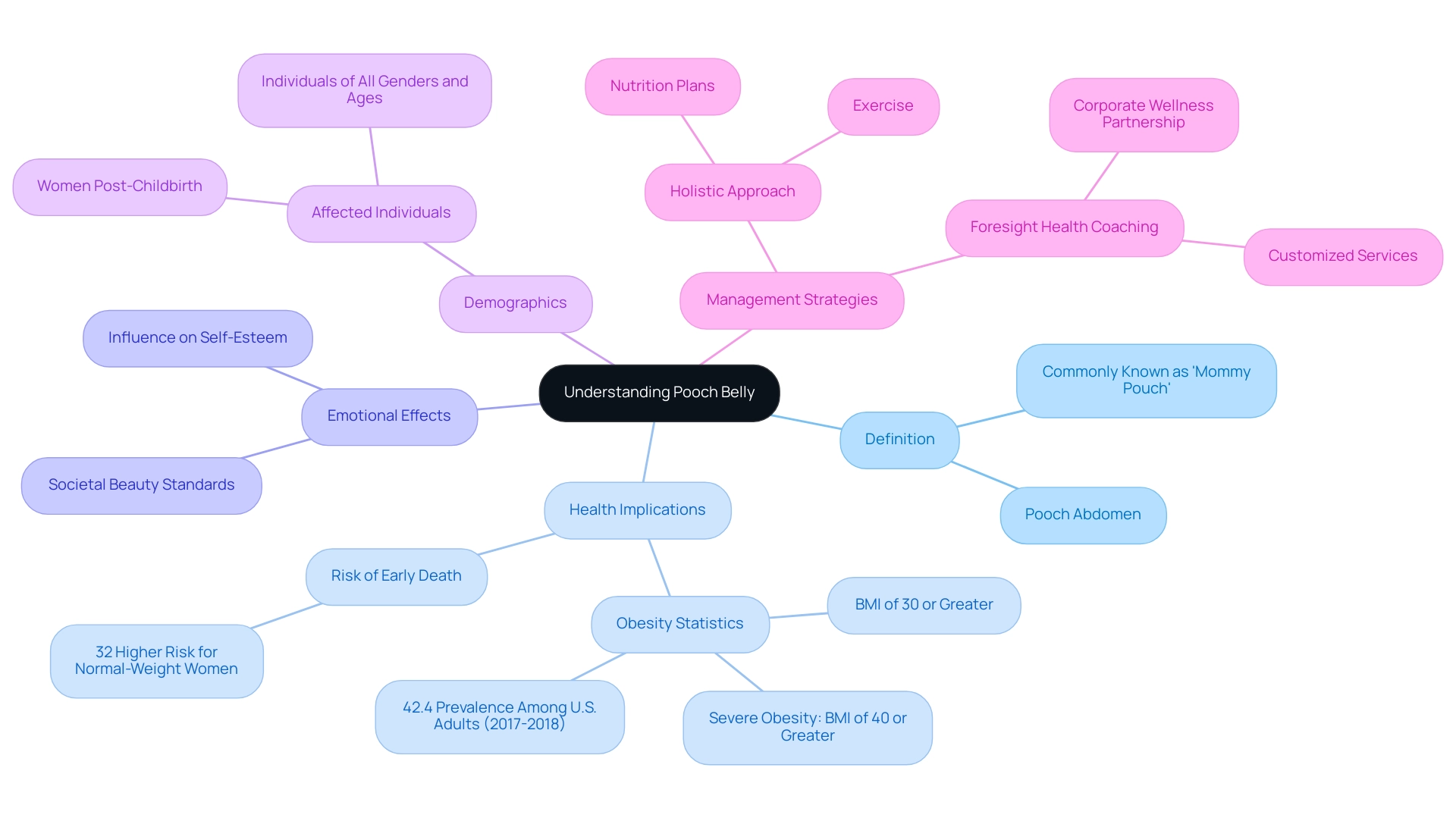
Exploring the Causes of Pooch Belly: What You Need to Know
To understand the phenomenon of pooch belly in dogs, it is essential to recognize that its emergence can be attributed to a combination of hormonal changes, genetic predispositions, and lifestyle habits. Hormonal fluctuations, particularly during significant life stages such as pregnancy and menopause, often lead to increased fat accumulation in the abdominal area. Research indicates that women undergoing menopause experience notable changes in body composition, which can elevate the risk of adverse health outcomes.
As highlighted in the case study titled "Menopausal Weight Management," effective management of these changes is crucial, emphasizing the need for tailored interventions for women facing these challenges.
Genetics also play a vital role in the tendency for canine abdominal fat. Certain genetic factors can influence body fat distribution, making some individuals more susceptible to abdominal fat accumulation. This genetic predisposition, combined with lifestyle choices, can significantly impact overall body shape and health.
Lifestyle habits, including diet and physical activity, are essential in managing weight in dogs. Nutritionists emphasize that a balanced diet rich in whole foods can mitigate the effects of hormonal changes and reduce fat storage. Moreover, poor posture and insufficient core strength can worsen the visibility of a protruding abdomen, underscoring the importance of maintaining proper posture and engaging in core-strengthening workouts.
As one nutritionist noted, "Incorporating more whole foods into your diet can help balance hormones and reduce abdominal fat."
Stress and emotional eating are also significant contributors to abdominal weight gain. When individuals experience stress, they may turn to food for comfort, leading to increased caloric intake and fat storage in the abdominal region. Dr. Barbara Kahn, a prominent expert in the field, states, "The message that you should take from this study should be less about the gender differences and more about the overall risks presented by central adiposity."
Understanding what is pooch belly is crucial for grasping these complex reasons and creating effective methods to tackle canine obesity and enhance overall health.
Furthermore, statistics from the WHI study reveal that BMI and waist circumference decreased in women taking estrogen and progestin therapy compared to those taking placebo, underscoring the impact of hormonal changes on body composition. Additionally, it is important to recognize that obesity is linked to sexual dysfunction and can negatively affect body image and self-esteem in women.
In summary, addressing canine obesity requires a holistic approach that considers hormonal changes, genetic factors, and lifestyle habits. By recognizing these interconnected elements, individuals can implement targeted strategies to improve their health and well-being.

The Effects of Pooch Belly: Physical and Emotional Implications
Understanding what pooch belly entails is crucial, as its presence can significantly impact both physical health and emotional well-being. Excess abdominal fat, particularly visceral fat, is associated with various health risks, including cardiovascular disease and diabetes. This type of fat can lead to discomfort and reduced mobility, hindering daily activities and overall quality of life.
Research indicates that adults should aim for seven to eight hours of restful sleep each night, as inadequate sleep can exacerbate weight gain and related health issues. To monitor visceral fat, measuring waist circumference at the navel level is recommended, with a measurement of 35 inches or larger in women indicating excess visceral fat.
Moreover, individuals with a protruding abdomen often face challenges related to self-esteem and body image, which can lead to social anxiety, particularly in appearance-focused environments. In the workplace, these emotional hurdles can manifest as decreased productivity and engagement. Studies reveal that body image concerns can result in significant productivity loss, with employees feeling less motivated and more distracted by their self-perception.
To tackle these challenges, organizations can implement personalized wellness programs that promote physical fitness and emotional support, guided by experienced coaches from Corporate Membership - Contact Our Health Coaches Today. Effective strategies for reducing abdominal fat include a combination of regular aerobic and strength training exercises, a nutrient-dense diet, adequate sleep, and stress management techniques, as highlighted in the case study titled 'Strategies to Reduce Abdominal Fat.' Notably, aerobic exercise is recognized as more effective than resistance training in optimizing fat distribution, according to James de Lemos, M.D.
By fostering a supportive culture that prioritizes health and well-being, organizations can help mitigate the emotional implications of body image issues, ultimately enhancing employee satisfaction and productivity. Expert opinions underscore that understanding what pooch belly entails and addressing both the physical and emotional aspects of a dog's abdomen is essential. Psychologists note that body image issues can create a cycle of negative emotions, adversely affecting workplace dynamics and personal performance.
By investing in comprehensive wellness initiatives, organizations can cultivate a healthier, more cohesive team environment, diminishing the stigma associated with body image and promoting overall well-being.
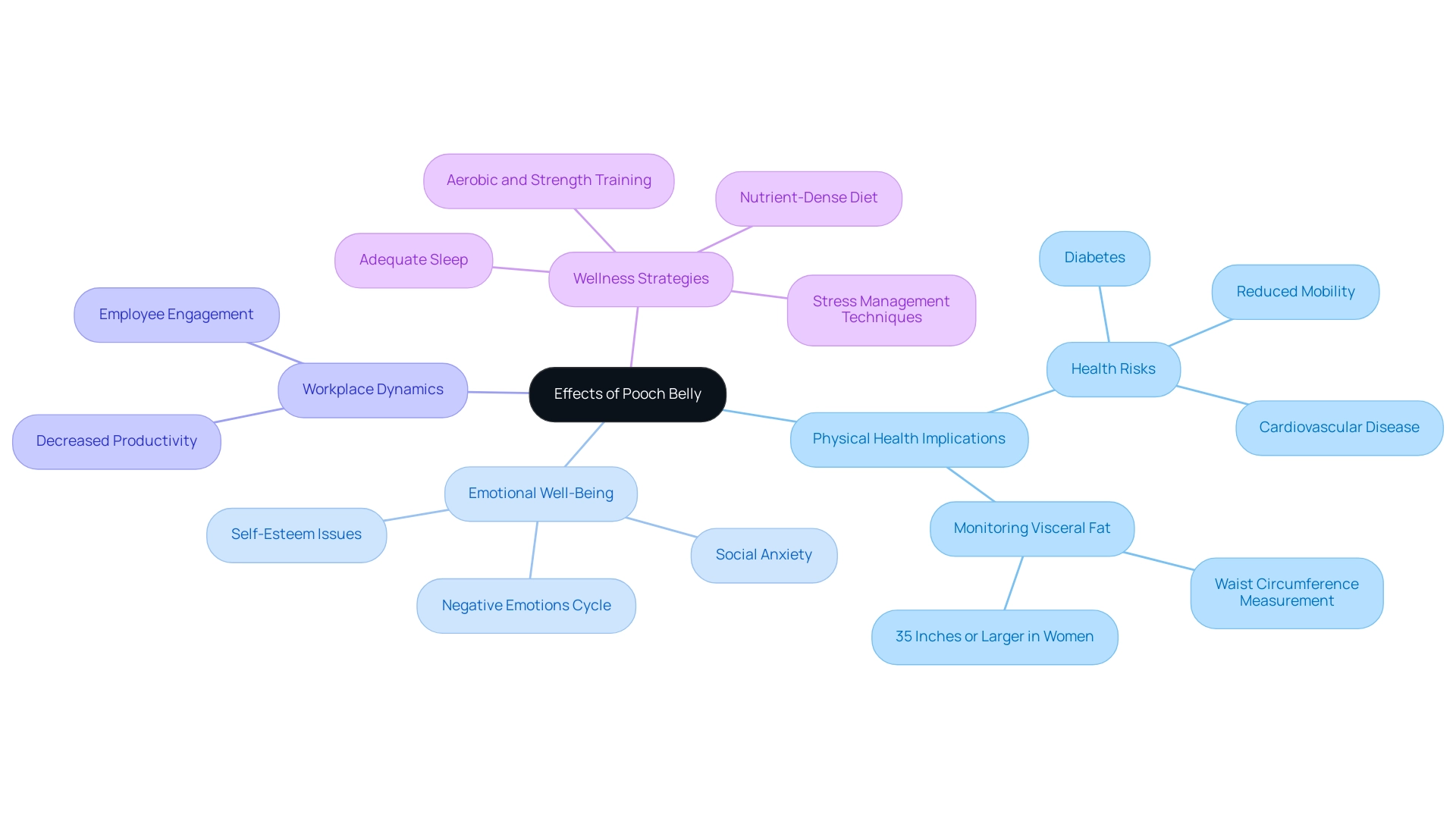
Debunking Myths: Common Misconceptions About Pooch Belly
Many myths surrounding what constitutes pooch belly can mislead those seeking effective solutions. A common misconception is that pooch belly in dogs results solely from overeating or insufficient exercise. While these factors certainly contribute, hormonal changes and genetic predispositions also play significant roles in its development.
For instance, hormonal fluctuations, particularly in women, can lead to increased fat storage in the abdominal area, complicating efforts to achieve a flat stomach.
Another prevalent misconception is the belief that targeted exercises can effectively reduce abdominal fat. However, research indicates that spot reduction is largely ineffective; focusing solely on abdominal exercises will not significantly reduce fat in that area. Instead, a holistic approach is essential for achieving lasting results.
This includes overall weight management, core strengthening, and lifestyle modifications such as improved nutrition and regular physical activity.
Incorporating a comprehensive wellness coaching app can significantly enhance this holistic approach. Such an app provides customized workouts, guided nutrition, and daily programming tailored to specific health goals. With features like a 350+ movement catalog, bi-weekly group calls, and an accountability and data hub, users can engage in targeted exercises combined with a balanced diet and cardiovascular activities to enhance overall fat loss and improve body composition.
As noted by Dr. Howard E. LeWine, a practicing internist and Chief Medical Editor at Harvard Health Publishing, "A comprehensive strategy is key to addressing weight management effectively."
Expert insights further debunk myths about dog abdominal causes, addressing what is pooch belly. Fitness professionals emphasize that a comprehensive strategy, rather than isolated exercises, is crucial to addressing this issue. By understanding what is pooch belly and the underlying factors contributing to canine obesity, individuals can adopt more effective strategies for weight management and overall health.
The app's features, such as direct messaging with coaches for personalized support, habit formation strategies, supplement advice, and a built-in community for motivation, empower users to stay engaged and accountable in their wellness journey.
The case study titled "Obesity Myths and Misunderstandings" highlights common myths and misunderstandings related to obesity, utilizing scientific publications to clarify the physiology and pathophysiology of obesity. This underscores the significance of clarifying misunderstandings related to what is pooch belly.
In summary, understanding what is pooch belly is essential for anyone aiming to effectively address canine weight issues. A well-rounded approach that considers all contributing factors, supported by a comprehensive wellness coaching app, will yield the best results, leading to improved health and well-being. For organizations looking to cultivate a healthier team culture, contacting Corporate Membership - Contact Our Health Coaches Today can provide valuable insights and partnership benefits tailored to enhance employee wellness.
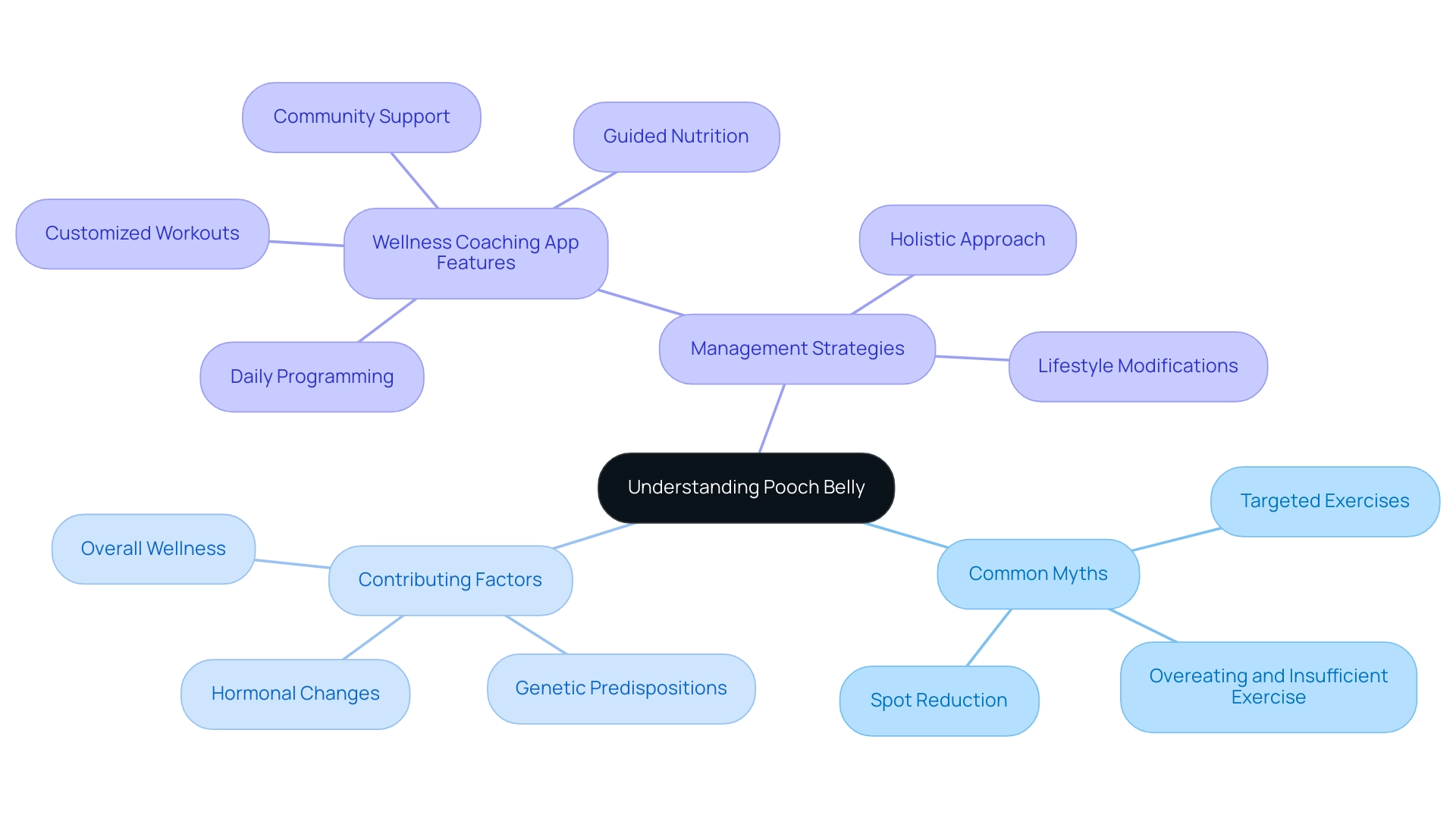
Effective Strategies for Reducing Pooch Belly: Tips and Techniques
To effectively reduce canine weight, individuals can implement a multifaceted approach that combines exercise, diet, and lifestyle changes, supported by the comprehensive health coaching services offered by Foresight Health Coaching. Regular physical activity is crucial; incorporating both strength training and cardiovascular exercises can significantly aid in burning fat and enhancing core strength. Research indicates that high-intensity exercise regimens are particularly effective at reducing abdominal fat and improving overall adipose tissue function, making them a valuable component of any fitness routine.
In addition to exercise, understanding what is pooch belly and incorporating a balanced diet plays a pivotal role in managing weight. Emphasizing whole foods, lean proteins, and healthy fats can create a nutritional foundation that supports weight loss and overall health. Mindfulness practices, including stress reduction techniques and ensuring adequate sleep, are also essential for maintaining hormonal balance and promoting well-being.
Participating in community or workplace wellness programs, like those offered by Foresight Health Coaching, can further enhance personal efforts. These programs not only provide essential support and motivation but also foster a culture of health within organizations. A study examining the effects of diet and exercise on abdominal fat in overweight to obese postmenopausal women found that both interventions led to significant reductions in abdominal fat, with the combination of diet and exercise yielding slightly greater results in subcutaneous fat loss.
The trial's strengths included a large sample size and a randomized design, which enhance the credibility of these findings.
Expert insights suggest that people should focus on consistency and variety in their exercise routines. As Jeff Horowitz, a Professor of Movement Science, notes, "Almost everyone gains weight as we age, even regular exercisers," highlighting the challenges people face in maintaining a healthy weight. Effective exercises for targeting excess abdominal fat include:
- Planks
- Bicycle crunches
- High-intensity interval training (HIIT)
By embracing these strategies, people can begin a successful journey toward decreasing dog weight and improving their overall health. Additionally, it is important to note that the run-in period for stabilizing body weight and evaluating protocol adherence typically lasts 4–6 weeks, providing a realistic timeline for achieving results.
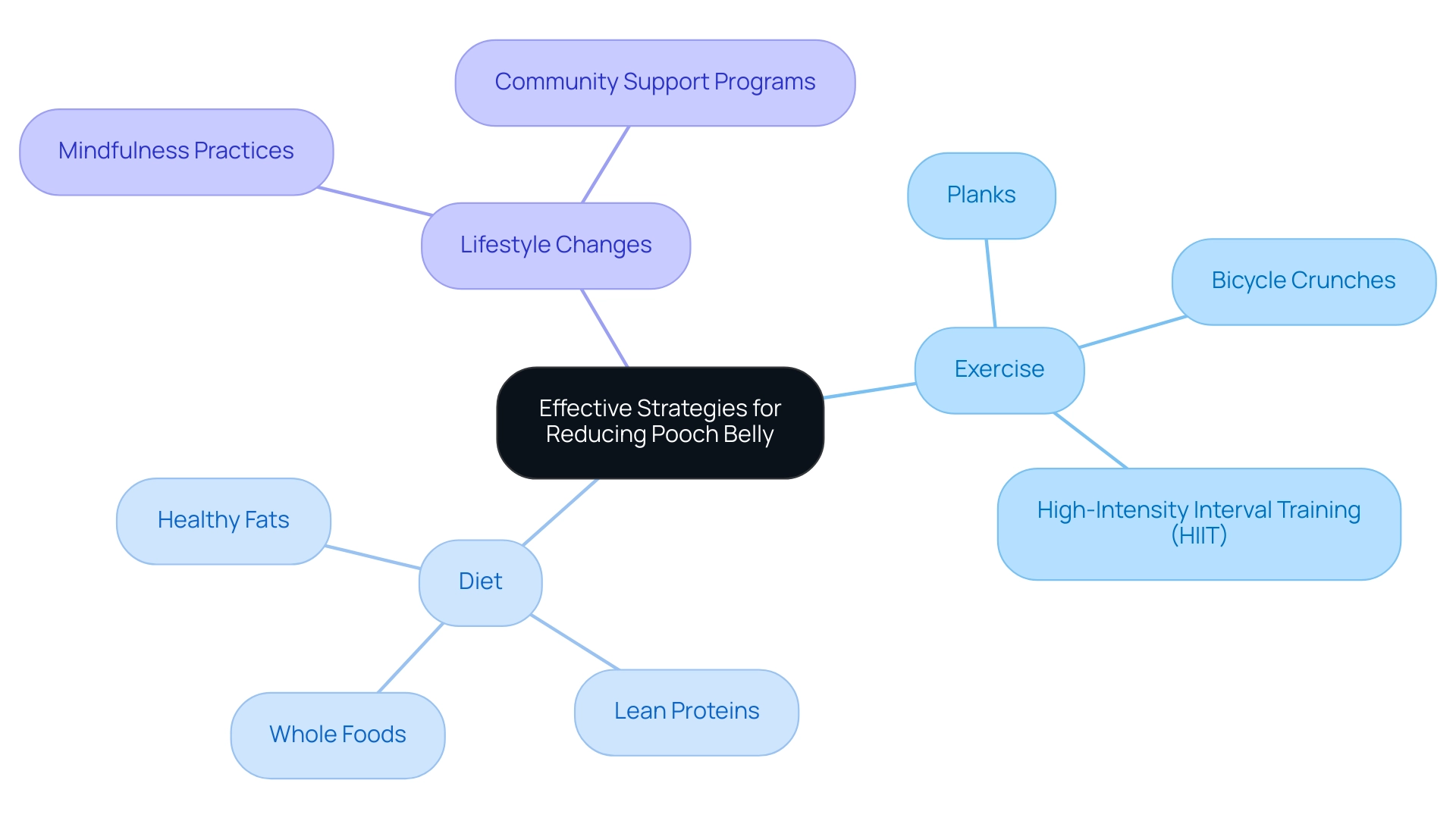
Lifestyle Changes to Combat Pooch Belly: Diet and Exercise Insights
Lifestyle adjustments are essential in effectively managing weight gain in dogs. A diet abundant in dietary fiber, fruits, vegetables, and lean proteins not only aids in weight regulation but also enhances digestion. As noted by Christina Catherine Dahm, "Dietary fibers improve both short-term and long-term cardiometabolic disease risk factors and outcomes, and thus should be on every menu."
Research indicates that increased dietary fiber intake is a strong predictor of weight loss and adherence to dietary plans, as demonstrated in the POUNDS Lost study. Participants who boosted their fiber consumption experienced significantly greater weight loss compared to those who did not. The study concluded that increased dietary fiber intake was the strongest predictor of weight loss and dietary adherence.
Regular exercise is equally important, combining both aerobic and strength training to maximize calorie burning and muscle development. Aerobic exercises, such as running or cycling, are effective for immediate calorie expenditure, while strength training builds muscle mass, which can elevate resting metabolic rate over time. Incorporating core stability activities, such as yoga or Pilates, further strengthens abdominal muscles and improves posture, contributing to a flatter appearance.
Organizations can facilitate these lifestyle changes by implementing wellness programs that promote physical activity and healthy eating habits among employees. Such initiatives not only foster a culture of health but also enhance overall workplace productivity. For instance, employees who engage in regular exercise—at least 30 minutes three times a week—report higher motivation levels and improved job satisfaction.
Furthermore, studies have shown a predicted 5.4 kg difference in weight loss between white and nonwhite participants, highlighting the effectiveness of dietary changes across different demographics.
By partnering with Foresight Health Coaching, organizations can access custom health coaching services tailored to their specific needs, showcasing their commitment to employee wellness. The logos of top firms and businesses that Foresight Health Coaching has collaborated with are displayed prominently, creating a professional atmosphere that underscores the credibility of these partnerships. Expert opinions underscore the significance of dietary adjustments in conjunction with exercise.
By investing in comprehensive wellness strategies, organizations can support their teams in achieving healthier lifestyles, ultimately leading to a more cohesive and resilient workforce.

Non-Surgical Treatments for Pooch Belly: Exploring Your Options
For individuals exploring non-surgical solutions to address abdominal fat, understanding what pooch belly entails is essential, as a variety of effective treatments are available. Prominent among these options are CoolSculpting and ultrasound therapy, both designed to target localized fat deposits without resorting to invasive surgical procedures. These non-invasive body contouring techniques not only aid in fat reduction but also enhance the overall appearance of the abdomen while promoting skin tightening.
The demand for non-surgical aesthetic procedures has surged dramatically, with a striking 54% increase since 2017, reflecting a growing preference for less invasive alternatives. In 2023 alone, approximately 34.9 million surgical and nonsurgical aesthetic procedures were performed, underscoring the popularity of treatments like CoolSculpting, which remains a leading choice for fat reduction.
Research indicates that CoolSculpting is particularly effective in diminishing persistent fat in the abdominal region, prompting many to inquire about pooch belly, thereby making it a favored option for those grappling with excess abdominal fat. Furthermore, ultrasound therapy has demonstrated promising results in enhancing the efficacy of body contouring treatments, providing a dual approach to fat reduction and skin tightening.
Case studies reveal that non-surgical aesthetic procedures, including CoolSculpting, have gained significant traction, with Botulinum Toxin and Hyaluronic Acid Fillers also ranking among the most sought-after treatments. The United States leads globally in the number of these procedures performed, closely followed by Brazil and Japan, highlighting the worldwide trend towards non-invasive aesthetic enhancements.
Consulting with a certified cosmetic surgeon is crucial to ascertain the most suitable non-surgical options tailored to personal needs and health considerations. Expert insights underscore the importance of personalized treatment plans to achieve optimal results, ensuring that patients receive the best care possible in their journey towards a more contoured abdomen.

When to Consider Surgical Options for Pooch Belly: A Guide
When discussing pooch belly, surgical options such as tummy tucks and liposuction are often considered if non-surgical methods have not yielded satisfactory results. Candidates for these procedures typically include individuals with significant excess skin or fat that cannot be improved through diet and exercise alone. Notably, tummy tucks have a success rate of approximately 86%, while liposuction boasts a success rate of around 90%. These figures underscore the effectiveness of surgical interventions for those grappling with stubborn fat deposits.
However, it is essential to recognize that overall health and wellness play a crucial role in body image and self-esteem. Foresight Health Coaching's partnership promotes a healthier, happier, and more cohesive team culture, positively influencing people's perceptions of their bodies. When contemplating surgical options, it is vital to maintain realistic expectations.
Consulting with a board-certified plastic surgeon is crucial to discuss potential risks, benefits, and recovery times associated with these surgical interventions. Expert opinions suggest that individuals should consider a tummy tuck when they have loose skin following significant weight loss or pregnancy, as this procedure can effectively remove excess skin and tighten abdominal muscles.
In addition to surgical options, non-surgical methods such as CoolSculpting offer alternatives for fat reduction. This non-invasive technique employs cold temperatures to target and eliminate fat cells, providing individuals with more options in their journey toward body confidence.
Research on patient outcomes indicates that both tummy tucks and liposuction can lead to improved body image and increased self-esteem. A case study involving patients who underwent these procedures revealed that many reported enhanced quality of life and greater satisfaction with their appearance post-surgery. Additionally, plastic surgeons emphasize the importance of a comprehensive evaluation to determine the most suitable surgical option based on individual needs and health conditions.
As noted by the Immediate-Past President of the American Society of Plastic Surgeons, "Presenting the data in an easy-to-read and understandable way is no simple task," highlighting the complexities involved in health-related decisions.
In summary, if you're wondering about pooch belly, surgical options like tummy tucks and liposuction can provide effective solutions, particularly when non-surgical methods fall short. Engaging with a qualified professional ensures that candidates are well-informed and prepared for the journey ahead. Furthermore, investing in health and wellness programs, such as those offered by Foresight Health Coaching, can foster a supportive environment that enhances both personal and professional well-being.
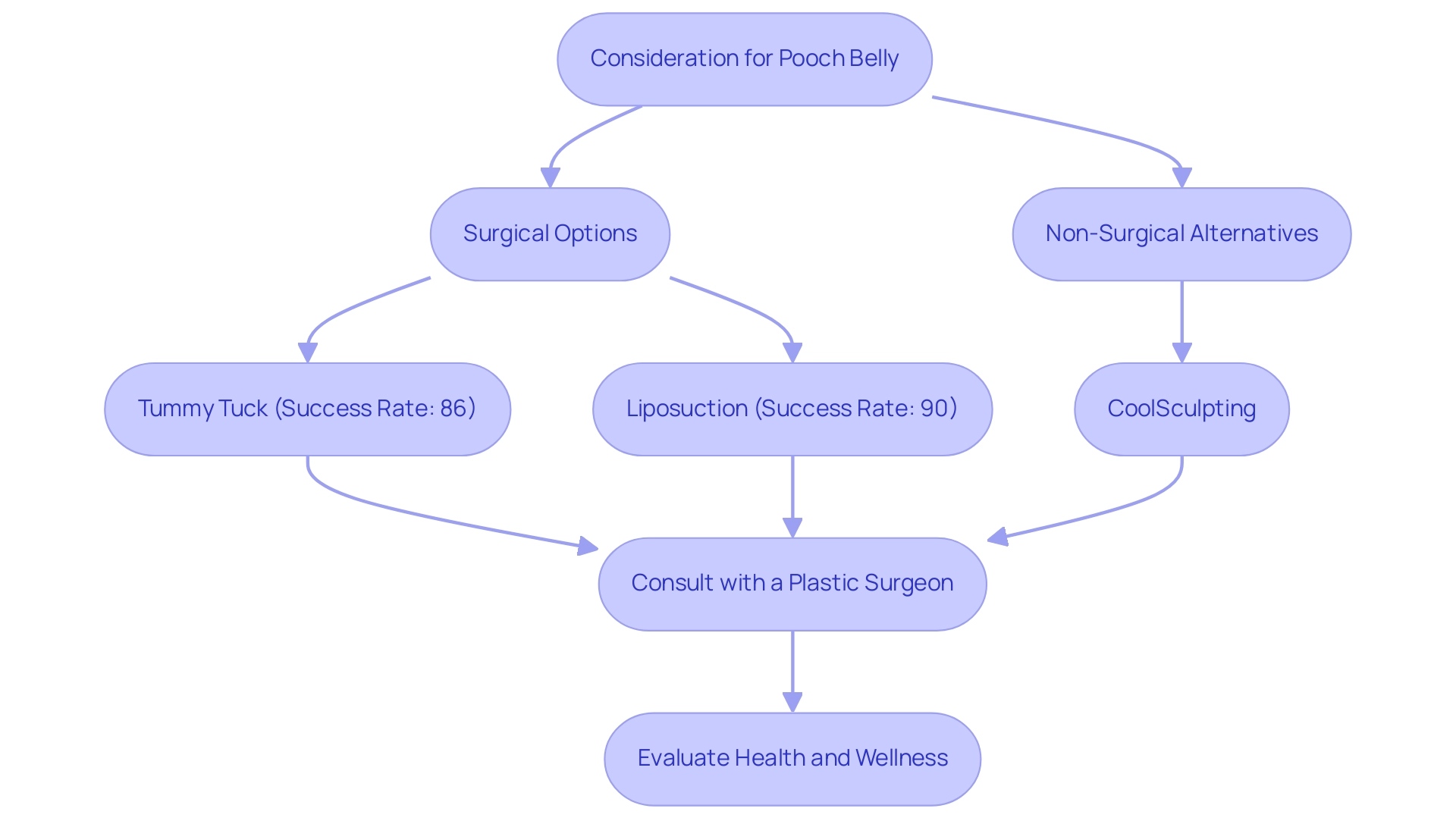
Conclusion
Understanding pooch belly is crucial as it encompasses both physical and emotional dimensions that significantly affect individuals' lives. This condition is influenced by hormonal changes, genetic factors, and lifestyle choices. It is evident that pooch belly affects a diverse range of people, particularly women post-pregnancy. Addressing it requires a comprehensive approach that includes:
- Exercise
- Nutrition
- Emotional support
Furthermore, common myths surrounding pooch belly are debunked, clarifying that it is not solely a result of overeating or lack of exercise. Instead, a holistic strategy that combines various methods—including:
- Targeted exercises
- Dietary changes
- Non-surgical treatments
proves essential. This evidence-based approach empowers individuals to take control of their health and well-being effectively.
Ultimately, tackling pooch belly transcends aesthetics; it involves reclaiming confidence and improving overall health. By implementing effective strategies and fostering a supportive environment—whether through personal wellness programs or workplace initiatives—individuals can combat the physical and emotional implications of pooch belly. The journey to a healthier self is achievable, and with the right resources and support, it can lead to a more fulfilling and confident life.
Frequently Asked Questions
What is pooch belly?
Pooch belly, also known as the mommy pouch, refers to a noticeable bulge in the lower abdominal area, typically situated below the navel. It is particularly common among women after childbirth but can affect individuals of all genders and ages due to factors like weight fluctuations, aging, and lifestyle choices.
Why is understanding pooch belly important?
Understanding pooch belly is essential because it impacts not just physical appearance but also emotional well-being and self-esteem. Research indicates that individuals with excess abdominal fat face higher health risks, including a 32% increased risk of early death compared to those classified as obese.
Who is affected by pooch belly?
Pooch belly can affect a diverse range of individuals, particularly women post-pregnancy. However, it can also occur in anyone due to natural body changes over time, weight fluctuations, and lifestyle factors.
How does pooch belly affect emotional well-being?
The term 'mommy pouch' can evoke feelings of inadequacy in new mothers, as societal beauty standards often overlook the realities of post-pregnancy bodies. This can lead to negative impacts on self-image and confidence.
What approaches do health experts recommend for addressing pooch belly?
Health experts advocate for a holistic approach that includes exercise and nutrition to manage pooch belly. Regular physical activity can help reduce abdominal fat while also improving mood and motivation, contributing to a more positive self-image.
What is the prevalence of obesity in the U.S.?
According to Craig M. Hales, M.D., the age-adjusted prevalence of obesity among U.S. adults was 42.4% in 2017–2018, highlighting the need for addressing issues related to abdominal fat.
What services does Foresight Health Coaching provide?
Foresight Health Coaching offers customized services, including nutrition plans and exercise programs, to help individuals manage excess weight effectively. They also provide resources and support to promote healthier lifestyle choices.
How can organizations help address pooch belly in the workplace?
Organizations can cultivate a culture of health and togetherness by partnering with programs like Foresight Health Coaching. This can assist individuals in managing challenges related to pooch belly, leading to a healthier and more self-assured workforce.

